The Side plank is a great bodyweight exercise that helps you develop the strength and stability of your core. Your muscles are strengthened without moving your limbs.
It is a strength-building exercise that engages a range of muscles and can also help boost your calorie burn.
The most common side plank is the forearm plank, which is held in which your body’s weight borne on forearms, elbows, and toes. There are many variations of it, such as: side plank rotation and Side plank hip dip.
In this article, we will discuss the following
- What is Side Plank
- Muscles Worked During Side Plank
- Benefits of Doing It
- How To Do Side Plank Properly
- The best variation of the Side plank

- What is Side Planks
- Muscles Worked During Side Plank Exercises
- Benefits Of Doing The Side Plank
- 1. Strengthening Upper and Lowe Body
- 2. Prevent Muscle Imbalances
- 3. Improve Functional movement
- 4. Safe and Effective Alternative to Crunches
- 5. Burn calories and body fat
- 6. Versatile exercise
- 7. Improves your balance.
- Forearm Side Plank
- How To Do Forearm Side Plank
- Techniques And Tips For The Perfect Side Plank
- 15 Best Ways To Do Side Plank Exercises (Variations)
- 1. Modified side plank (Side Plank on knee)
- 2. High Side Plank
- 3. Incline Side Plank
- 4. Side Plank Dips
- 5. Side Plank Lateral Raise
- 6. Copenhagen Plank
- 7. Side Plank with Hip Abduction
- 8. Tree Side Plank
- 9. Side Plank with Knee Tuck
- 10. Side Plank With Rotation
- 11. Forearm Side Plank Crunch
- 12. Rolling Side Plank
- 13. Side Plank with Row
- 14. Stability Ball forearm Side Plank
- 15. Medicine ball Side plank
- FAQs
- What is the side plank good for?
- How long should I do a side plank
- How often should you do side planks?
- Do side planks give you abs?
- Do side planks give you a smaller waist?
- Conclusion
- References
What is Side Planks
The side plank is one of the best abs exercises for strengthening the oblique abdominal muscles, which don’t get worked as much during abs exercises such as crunches. It also targets the back, hips, and leg muscles.
For the side plank, you will hold your body on your side in a straight position, supported only by one arm and the side of one foot. Strong obliques can be quite useful as core stabilization muscles.
Obliques are an important part of your entire core that is beneficial during rotational exercises and balancing your way through everyday life. These oblique exercises engage far more than just your so-called “side abs” and make you a stronger human overall.
Muscles Worked During Side Plank Exercises
The side plank position is an effective component of your workout, as it engages a wide range of major muscle groups.
- Primary muscles worked:: External and internal obliques, transversus Abdominis, abdominis, and hip muscle.
- Secondary muscles worked: gluteus maximus (glutes), quadriceps (quads), and hamstrings.
- In addition, the position uses the Serratus Anterior, lateral deltoids, and Trapezius of the upper body
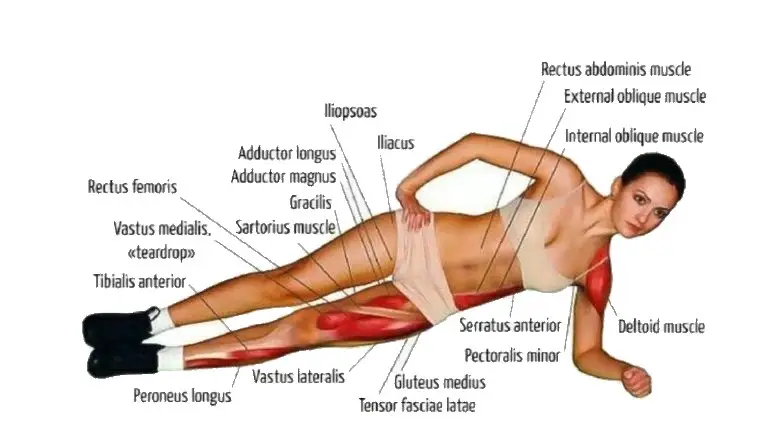
Benefits Of Doing The Side Plank
1. Strengthening Upper and Lowe Body
When you do side plank exercises, you work all the muscles in your core and receive all of the benefits of a strong core. In addition to strengthening the muscles in your core, planks also work the following muscles:
- Upper body: Trapezius, Serratus Anterior, lateral deltoids, and Trapezius, Rhomboid, Anterior delts, arms.
- Lower body: Calf muscles, gluteus maximus (glutes), quadriceps (quads), and hamstrings.
2. Prevent Muscle Imbalances
The plank exercise strengthens the core of the body. When muscles are equally developed on both sides of the body, the result is better posture, more spinal support, and less lower-back pain.
3. Improve Functional movement
Side planking improves functional movement, the kind of movement that is needed to live life. Squat, bending, running and lifting are all functional movements initiated in the core.
4. Safe and Effective Alternative to Crunches
Crunches and sit-ups only work the muscles on the front or side of the abs, so it’s necessary to do side and back strengthening exercises as well.
However, planks work the entire core, as well as many other muscles in the body.
5. Burn calories and body fat
Side plank variation is a combination of strength and cardiovascular training.
It can help you burn calories and regulate your weight.
6. Versatile exercise
The main advantage of side planks is the variety of possible exercises.
There is a plank routine for everyone and every fitness level.
7. Improves your balance.
As a balancing exercise, a side plank can help improve your sense of balance and coordination.
Forearm Side Plank
The forearm side plank is one of the best abs exercises for strengthening the oblique abdominal muscles, which don’t get worked as much during abs exercises such as crunches.
You will hold your body on your side in a straight position, supported only by one arm and the side of one foot. Strong obliques can be quite useful as core stabilization muscles.
If you are new to it, I recommend that you master the basic knee plank before moving on to the full side plank variation.
- Level: Beginners To Intermediate
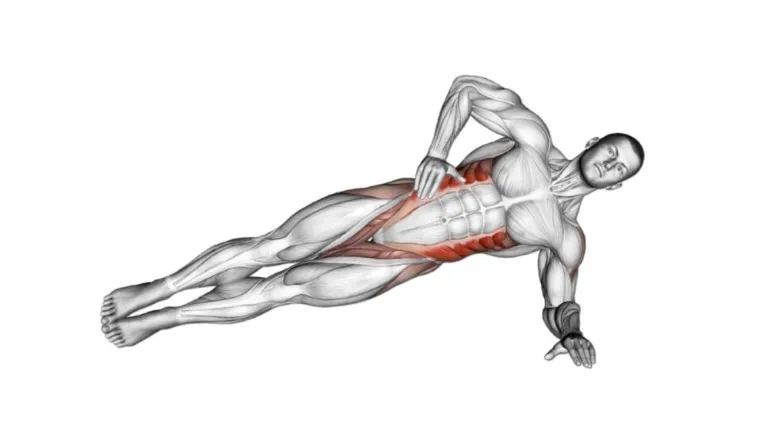
How To Do Forearm Side Plank
- Get in a side plank position by lying on your right side on the floor with your left foot resting on top of the inner side of your right foot and your left arm resting on top of your left side.
- Raise your body by placing your right forearm flat on the floor so that it’s perpendicular to your torso.
- Lift your torso until your right upper arm is straight underneath you, with your elbow bent 90 degrees and your forearm flat on the floor.
- In this position, only your right forearm and the outer side of your right foot are contacting the floor and your body forms a diagonal line that is at about a 20-degree angle to the floor.
- Keep your abs pulled in tight and hold this position for as long as you can, and then repeat on the left side.
Techniques And Tips For The Perfect Side Plank
When you’re first starting out, it can be helpful to focus on proper form and technique. Here are the most common side plank mistakes and step to fix them.
It takes practice to perform planks correctly, and until your muscles get a little stronger, it will be very challenging.
- Do not let your hip sag or your butt rise. Ensure your body is straight and rigid.
- Squeeze your abs and glutes throughout the movement for stability.
- Don’t let your shoulders roll forward. Keep your chest up and shoulders back.
- Make sure that you aren’t rotating toward the ground.
- Your neck should be in line with your body, not tilted up, which could strain the neck. Keep your gaze down at the floor.
- For the beginner, try holding the plank position for 10-20 seconds. Over time, work up to 30, 45, or 60 seconds.
- Don’t focus too much on the clock, quality is more important than quantity. When your form begins to suffer, it is time to give up.
- Although it’s important to concentrate on perfect form, don’t forget to breathe, as lack of oxygen can cause dizziness or nausea.
15 Best Ways To Do Side Plank Exercises (Variations)
The best side plank exercise and its variations to build a strong core are listed here. Once you’ve mastered the basic plank, there are many variations you can try to make the exercise more challenging.
- If you are new to performing sides, you may want to apply a few modifications to make the exercise easier. One way to do knee side plank and another way to reduce the time of plank.
- If you are looking for a more advanced variation to stimulate different muscle fibers in the core, then try elevated plank, Side Plank With Row, Stability Ball Forearm and Medicine ball Plank.
1. Modified side plank (Side Plank on knee)
Modified Knee side plank is the beginner variation of the plank exercise.
If you’re new to planking, you should master this modified knee plank before moving on to the plank variation.
Once you master the plank on your knees, you can move up to a full forearm plank.
- Level: Beginners
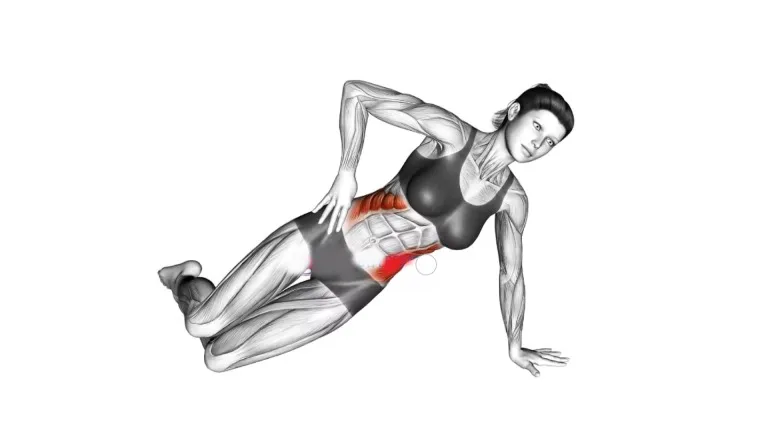
How To Do Knee Side Plank
- Get in a side plank position by lying on your right side on the floor with your left knee resting on your right knee and your left arm resting on top of your left side.
- Raise your body by placing your left arm flat on the floor.
- Lift your torso until your left upper arm is straight underneath you.
- Your body forms a diagonal line that is at about a 20-degree angle to the floor.
- Keep your abs pulled in tight and hold this position for as long as you can, and then repeat on the left side.
2. High Side Plank
The ability to maintain a high level of stability with the body in a high side plank position is a benchmark for fitness and core strength.
This exercise challenges your balance and requires you to activate and work your stabilizer muscles as you hold your plank.
- Level: Beginners To Intermediate
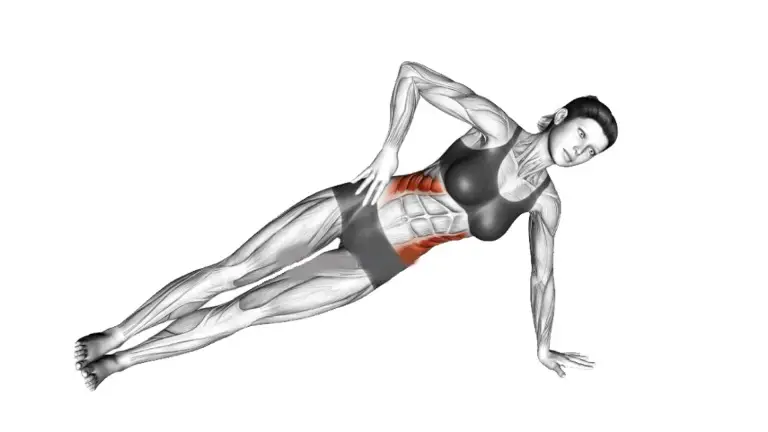
How To Do High Side Plank
- Get in a plank position
- Raise your body by placing your left palm flat on the floor so that it’s perpendicular to your torso.
- In this position, only your left arm and the left foot are making contact with the floor.
- Hold the position for as long as you can, and then repeat on the other side.
3. Incline Side Plank
The incline side plank is one of the beginner-friendly exercises. As the surface becomes more inclined, it becomes easier to plank.
- Level: Beginners
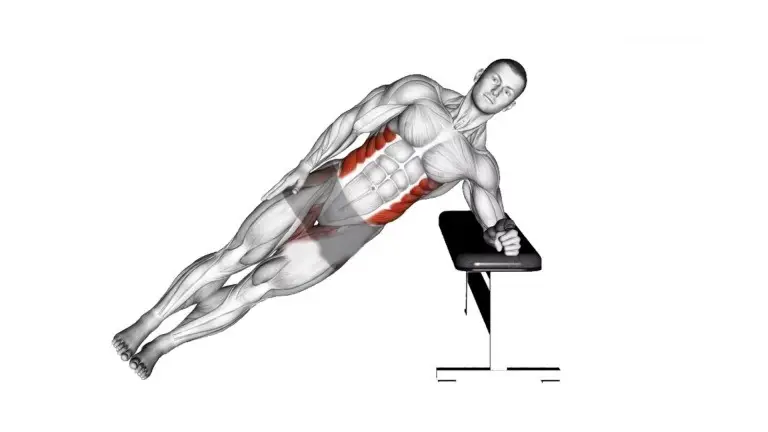
How To Do Incline Side Plank
- Set Up an elevated surface.
- Place your elbow in the center of the bench and align it with your shoulder.
- Keep your legs and body straight.
- Establish a straight line from your head to your heels.
- Hold this position for a set amount of time.
4. Side Plank Dips
The side plank dip is also known as the Plank With Hip Dip that you can do to target the obliques and outer thighs.
Make the lying side hip raise exercise easier by bending your knees and supporting your lower body on the side of your knee instead of the side of your foot.
Make the exercise more difficult by holding a weight on your hip.
- Level: Beginners To Intermediate
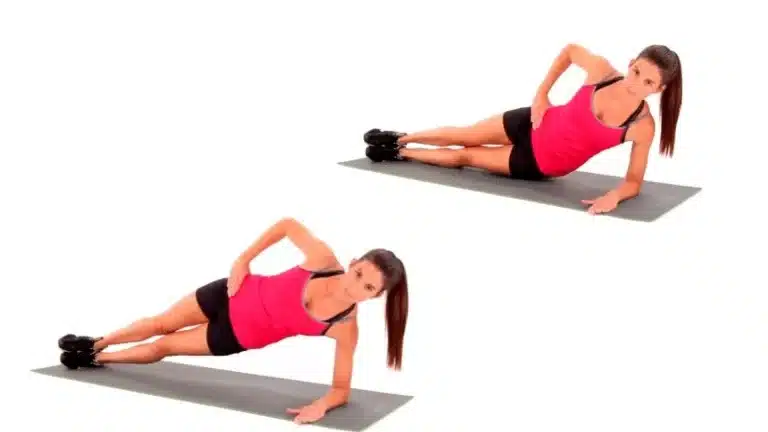
How To Do Side Plank Dips
- Lie on the floor on your left side with your elbow directly beneath your shoulder and legs stacked.
- Straighten your body and legs.
- Your feet should be together, and your hip should be resting on the floor.
- Brace your abs and lift your hips off the floor until you’re balancing on your forearm and feet and your body forms a diagonal line.
- Slowly bring your hips back to the floor. Repeat on your right side.
5. Side Plank Lateral Raise
The side plank lateral raise is an exercise that combines an isometric plank hold with a dumbbell raise to target both the core and the shoulders.
For this movement, you may not be able to use much weight without disrupting your balance, but even at lightweight, it is a movement that can help address multiple muscle groups in a time-efficient workout.
- Level: Intermediate To Advanced

How To Do Side plank lateral raise
- Get in a side plank position by lying on your left side on the floor.
- Hold a dumbbell in your top hand, with your arm resting along the side of your body.
- Slowly raise the weight, making sure not to extend beyond your shoulder.
- Slowly lower your arm back down. Complete the desired number of repeats.
- Repeat the movement on your right side.
6. Copenhagen Plank
The side plank with feet on the bench is a progression from a normal side plank that targets the core, inner thigh and groin- the adductors.
Performing with your feet raised also increases the resistance on your shoulders and triceps.
- Level: Intermediate To Advanced
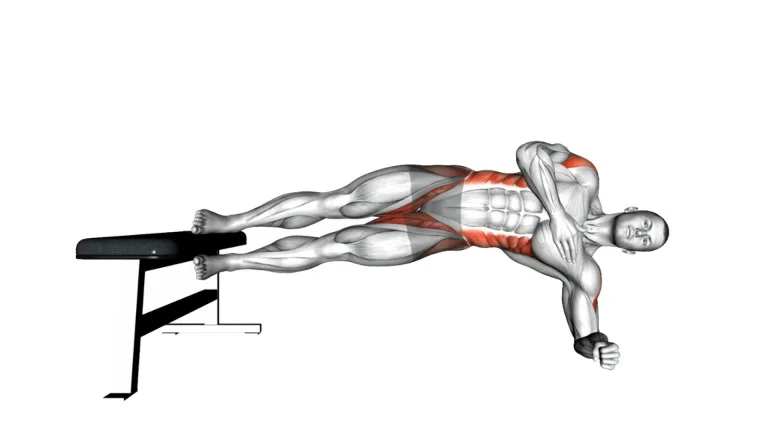
How To Do Copenhagen Plank
- Get in a plank position with forearm on the floor.
- Place the top foot onto a chair, bench or another stable surface, while holding the bottom leg off the ground.
- Maintain a straight line from your shoulder to your ankle. Hold for 20-30 seconds
- Slowly lower back to the starting position.
- Repeat on your other side.
7. Side Plank with Hip Abduction
The side plank hip abduction is an advanced variation of plank exercise that you can do to target the obliques and outer thighs.
The hip abductors move your legs away from your body and rotate them at the hip joint. This is important because it keeps your knee and hip joints stable.
- Level: Intermediate To Advanced
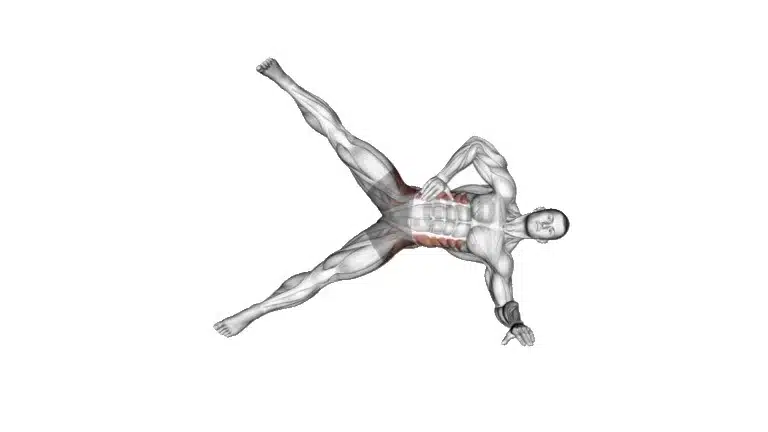
How To Do Side Plank with Hip Abduction
- You should get into the plank position.
- Straighten your body and legs.
- Lift your right leg at least 6 inches.
- Slowly bring your feet back together and lower your hip to the floor.
- Repeat the exercise on your other side.
8. Tree Side Plank
It is a more advanced variation of the balancing pose. Tree plank combines the benefits of both side plank and tree pose.
It is supported by one hand and the outer edge of one foot. The other leg forms a triangle shape, with the sole pressed into the inner thigh or calf.
- Level: Intermediate To Advanced

How To Do Tree Plank
- Lift into the side plank position and bend your top leg and place your foot flat on the inside of your upper thigh.
- Open your top knee up toward the ceiling and squeeze your butt as you drive your foot into your leg and keep your bottom hip up.
- Keep your abs pulled in tight and hold this position for as long as you can.
9. Side Plank with Knee Tuck
It strengthens the core with an emphasis on the obliques. The movement also demands hip control, balance, and coordination.
- Level: Intermediate To Advanced
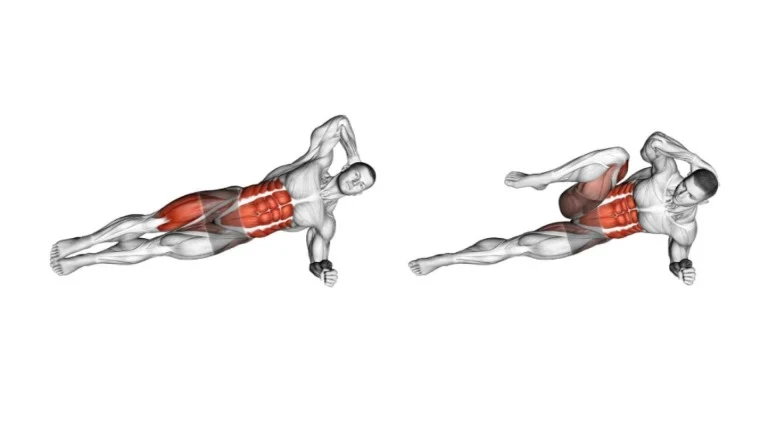
How To Do Side Plank With Knee Tuck
- Get in a forearm side plank position.
- Raise your body by placing your right forearm flat on the floor so that it’s perpendicular to your torso.
- Lift your torso until your right upper arm is straight underneath you, with your elbow bent 90 degrees and your forearm flat on the floor.
- Lift your left leg and bend that knee, bring your top knee toward your chest.
- Pause and then return to starting position.
10. Side Plank With Rotation
The side plank with rotation exercise develops shoulder and core strength & stability, and may even help improve spinal mobility.
To maximize these benefits, make sure that you are doing this exercise perfectly.
- Level: Intermediate To Advanced
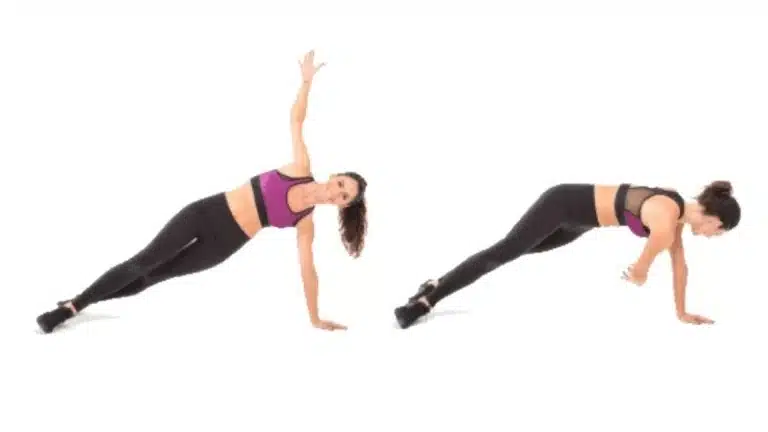
How To Do Plank With Rotation
- Get in a side plank position.
- Raise your body by placing your left arm (palm) flat on the floor so that it’s perpendicular to your torso.
- Lift your torso until your left upper arm is straight underneath you.
- In this position, only your left arm and the outer side of your left foot are making contact with the floor.
- Reach under and behind your torso with your right hand, keeping your abs braced.
- Then repeat on the right side.
11. Forearm Side Plank Crunch
Combine your standard crunches with side plank exercise into one move that will challenge your balance, tone up your waist, and strengthen your core.
This exercise impacts your obliques doubly hard.
The side of the body that is closest to the ground has to stay engaged the whole time to keep the body stable, while the side you’re crunching contracts and relaxes over and over again.
- Level: Intermediate To Advanced
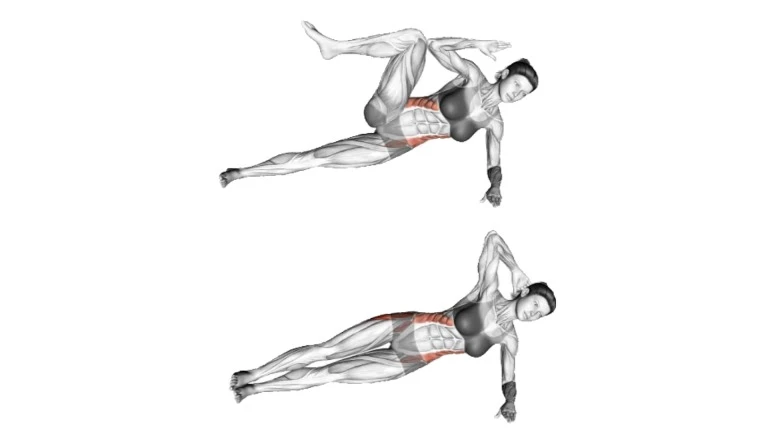
How To Do Forearm Side Plank Crunch
- Get in a plank position. Raise your body by placing your right forearm flat on the floor.
- Lift your torso until your right upper arm is straight underneath you, with your elbow bent 90 degrees and your forearm flat on the floor. Extend your left arm over your head.
- Lift your left leg and drive your knee toward your torso.
- At the same time, bring your left arm in toward your knee in a crunch movement.
- Continue for a set amount of time, and then repeat on the other side.
12. Rolling Side Plank
The rolling side plank is a core stability exercise that improves strength and endurance. The exercise also increases strength in the lower back and shoulders.
The rolling plank involves switching between left and right planks, with a brief forearm plank in between.
Combining the three poses into one fluid movement challenges your stability and works all of your muscles in your core.
- Level: Intermediate To Advanced
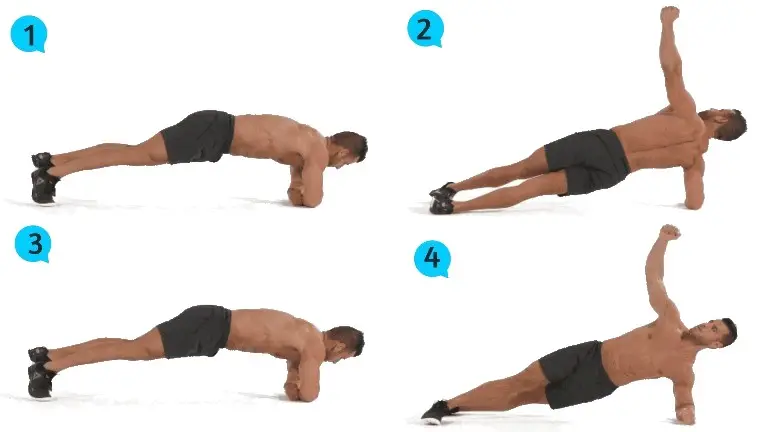
How To Do Rolling Plank
- Get in a forearm plank position.
- Your body should form a straight line from your shoulders to your ankles.
- Now roll to your left forearm into a side plank with your right arm raised above you.
- Then roll back to the original plank position.
- Roll to your right forearm into a side plank with your left arm raised above you, and then return to the original plank.
13. Side Plank with Row
The side plank row is an advanced variation of the standard plank, performed by pulling the handle attached to a low pulley cable machine.
You can include this exercise in your regular ab workout routine to improve the core-rotational resistive ability.
- Level: Advanced
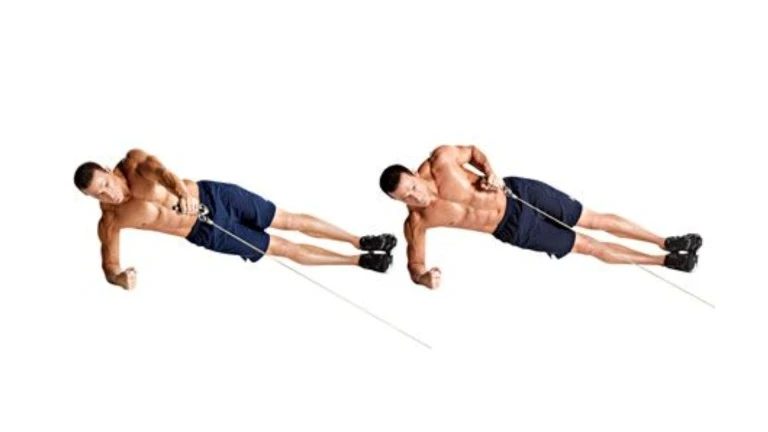
How To Do Plank with Row
- Use a cable machine and attach a handle to the low pulley with your left hand.
- Brace your core and raise your body into a side plank on your right side.
- Bend your left elbow and pull the handle to your rib cage, keeping your hips pushed up and forward.
- Slowly straighten your arm back in front of you.
- Complete all reps on your left side, then switch to your right side, grab the handle with your left hand, and repeat.
Tips
- Avoid letting your hips sag during this oblique exercises.
- Keep elbows tucked in while performing row. Focus on squeezing your shoulder blade back.
14. Stability Ball forearm Side Plank
Stability ball exercises have become popular because they have many benefits. They work the entire core, including the obliques, abdomen, lower back, gluteus, and thighs, and they also increase spinal stability, balance, and coordination.
These unstable planks are more challenging than their stable counterparts.
- Level: Advanced
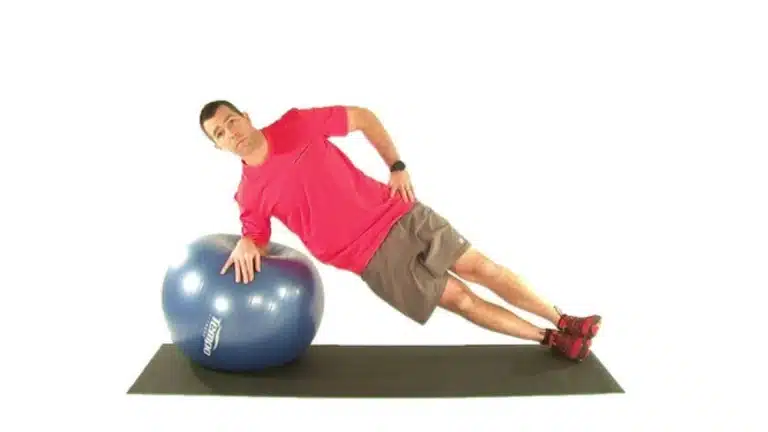
How To Do It
- Place your elbow in the center of the stability ball and align your shoulder with your elbow.
- Press your forearm into the stability ball to support the shoulder joint.
- Stack your hips and feet on top of one another to create a straight line from your head to your heels, actively.
- Hold this position for a set amount of time.
15. Medicine ball Side plank
Using a medicine ball for your press-ups challenges your body and adds a degree of instability to recruit more muscles.
Level: Advanced
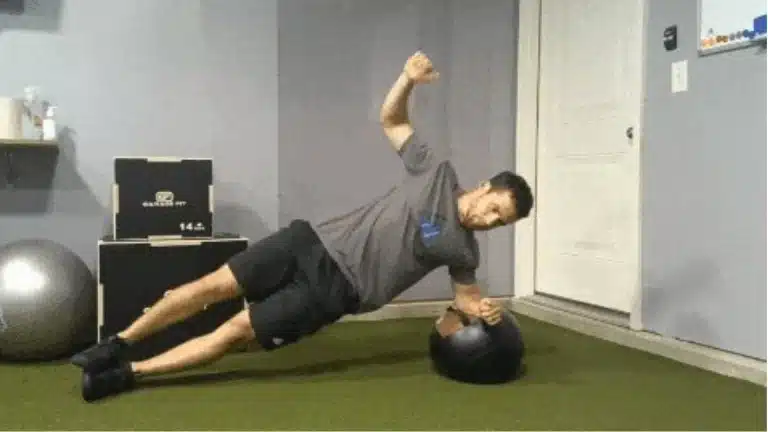
How To Do It
- Place your elbow on the medicine ball.
- Keep your glutes and core muscles contracted.
- Raise the body from the ground. Your body should be straight from your shoulders to your ankles.
- Hold this position for a set amount of time.
FAQs
What is the side plank good for?
The side plank is a great exercise for training the core, upper body, and lower body all at once.
It strengthens your spine, your deltoids and trapezius, and your abdominal and oblique muscles.
Which will help them develop a strong posture as they get stronger. A good posture can help with health issues and prevent the development of others.
How long should I do a side plank
It is more beneficial to hold a side plank for 30 seconds with proper form than hold it for 3-5 minutes with poor form.
Your goal should be to maintain perfect form and maximum tension for as long as possible.
How often should you do side planks?
I recommend that you plank two to four times a week. If you do planking 3-4 day per week, it will help improve your body posture by strengthening your back, neck, chest, shoulder, and abdominal muscles.
Do side planks give you abs?
Side planking is the best exercise for strengthening your abs and oblique muscles.
Do side planks give you a smaller waist?
Planks are a great way to work out your entire body, flatten your tummy and give you a smaller waist. It burns more calories each session than other abdominal workouts like sit-ups and crunches.
Conclusion
These side plank workouts are highly recommended for anyone interested in building core muscles and gaining strength.
Not only does it allow for targeted muscle development, but it also provides overall core development.
It is simple and does not require more scientific information. If you do it regularly, the results will speak for themselves.
Thanks for reading, enjoy your workout!
References
- Calatayud J, Casaña J, Martín F, Jakobsen MD, Colado JC, Andersen LL. Progression of core stability exercises based on the extent of muscle activity. Am J Phys Med Rehabil. 2017;96(10):694-6. doi:10.1097/PHM.0000000000000713
- A Murtezani, H Hundozi, N Orovcanec, S Sllamniku, T Osmani: A comparison of high intensity aerobic exercise and passive modalities for the treatment of workers with chronic low back pain: a randomized, controlled trial: PMID: 21602759
- D’Agata, Michele N. Staub, Jason P. Scavone, Daniel J. Kane, Gregory M. The Effect of External Dissociative Stimuli on Plank Duration Performed by Male Collegiate Soccer Players Journal of Strength and Conditioning Research: October 12, 2022 – Volume – Issue – 10.1519/JSC.0000000000004371 doi: 10.1519/JSC.0000000000004371
- Snarr, Ronald L. Esco, Michael R Electromyographical Comparison of Plank Variations Performed With and Without Instability Devices. Journal of Strength and Conditioning Research: November 2014 – Volume 28 – Issue 11 – p 3298-3305.
- Byrne, Jeannette M.; Bishop, Nicole S.; Caines, Andrew M.; Crane, Kalynn A.; Feaver, Ashley M: Effect of Using a Suspension Training System on Muscle Activation During the Performance of a Front Plank Exercise doi: 10.1519/JSC.0000000000000510
- Szafraniec R, Barańska J, Kuczyński M. Acute effects of core stability exercises on balance control. 3.Acta Bioeng Biomech. 2018;20(4):145-151.
- Bushman B PhD. Complete Guide to Fitness and Health 2nd Edition. American College of Sports Medicine. Human Kinetics. 2017.
- Chang W-D, Lin H-Y, Lai P-T. Core strength training for patients with chronic low back pain. J Phys Ther Sci. 2015;27(3):619-622. doi:10.1589/jpts.27.619

Manish brings over 10 years of hands-on experience in weight lifting and fat loss to fitness coaching. He specializes in gym-based training and has a lot of knowledge about exercise, lifting technique, biomechanics, and more.
Through “Fit Life Regime,” he generously shares the insights he’s gained over a decade in the field. His goal is to equip others with the knowledge to start their own fitness journey.
